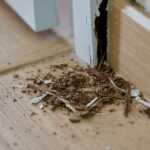Effective Bed Bug Removal: Techniques and Tips
Need effective bed bug removal? This guide covers preparation, identification, and treatment techniques to help you reclaim your home.
- Effective bed bug removal requires thorough preparation, including reducing clutter, vacuuming, and following pest control instructions to ensure successful treatment.
- Integrated Pest Management (IPM) combines chemical and non-chemical methods, emphasizing regular monitoring, environmental modifications, and professional assistance for long-term effectiveness against bed bugs.
- Homeowners should adopt preventive measures, such as using mattress encasements and minimizing clutter, to maintain a bedbug-free environment and reduce the likelihood of future infestations.
Preparing Your Home for Bed Bug Treatment
Effective bed bug control starts long before the first treatment is applied. Preparation ensures the treatment process goes smoothly and successfully. One of the first steps is to reduce clutter in your home. Bed bugs love to hide in piles of clothing, stacks of papers, and other cluttered areas, making it difficult to eliminate them. Reducing clutter eliminates potential hiding spots and makes it easier for pest control professionals to access and treat affected areas.
Another critical step is vacuuming. This simple yet effective method can instantly eliminate many bed bugs, especially in the early stages of infestation. Vacuuming removes bed bugs from carpets, upholstered furniture, and other surfaces, reducing the overall population and making it easier to manage the infestation. Be sure to dispose of the vacuum contents in a sealed bag to prevent any escapees from re-infesting your home.
Finally, always follow the instructions provided by your pest control company. Proper preparation ensures that the treatment is thorough and effective. This might include washing and drying bed sheets and clothing on the highest heat setting, moving furniture away from walls, and sealing any cracks or crevices where bed bugs might hide. Taking these steps paves the way for successful bed bug treatment.
Identifying Bed Bug Infestations
Identifying a bed bug infestation early can save you a lot of trouble and expense. Physical signs of bed bugs are often the first indication that you have an infestation. Look for rusty or reddish marks on your bedding, which are caused by crushed bugs. These stains are a telltale sign that bed bugs are present in your sleeping areas. Additionally, you may find small, dark spots on your mattress, which are bed bug excrement.
Bed bugs are experts at hiding in various locations around your home. Common hiding places include the seams of mattresses and couches, folds of curtains, and behind loose wallpaper. They can also be found in cracks and crevices in walls and infested furniture. To find bed bugs, you need to inspect these areas thoroughly. Moving furniture away from walls can enhance the efficacy of inspections and treatments. If you want to learn more about bed bugs hiding, be sure to check these spots carefully.
Cleaning and organizing your home are vital first steps in managing bed bugs. These pests thrive in cluttered environments, so keeping your living spaces tidy can help you get rid of them and getting rid of clutter can make a significant difference to kill bugs.
Integrated Pest Management (IPM) emphasizes a multi-faceted strategy that includes thorough inspections and monitoring to identify bed bug infestations. Staying vigilant and proactive helps catch a small infestation before it escalates.
Non-Chemical Methods to Eliminate Bed Bugs
When it comes to eliminating bed bugs, non-chemical methods can be highly effective and environmentally friendly. One such method is steam treatment. Using steam at high temperatures, around 212°F (100°C), can instantly kill bed bugs and their eggs on contact, making it an excellent option for killing bed bugs. This method is particularly effective for localized infestations and can be used on mattresses, upholstered furniture, and other infested items.
Heat treatments are another powerful tool in the fight against bed bugs. By placing infested items in a clothes dryer on the highest heat setting, you can eliminate bed bugs and their eggs from fabrics. Cold treatment is also an option; infested items can be frozen for four days to kill all life stages of bed bugs. These methods are safe, non-toxic, and can be done at home with minimal equipment.
Diatomaceous earth is another non-chemical treatment that can help eliminate bed bugs. This natural powder causes bed bugs to die by dehydrating them through moisture absorption. When applied to cracks, crevices, and other hiding places, diatomaceous earth can significantly reduce bed bug populations.
Non-chemical methods are an excellent first line of defense and can be used in conjunction with other treatments for maximum effectiveness.
Chemical Treatments for Bed Bugs
Chemical treatments are often necessary to eliminate severe bed bug infestations. The Environmental Protection Agency (EPA) has approved over 300 pesticide products specifically for controlling bed bugs. These pesticides are classified into seven categories, including pyrethrins, desiccants, and neonicotinoids. Each class has a unique mode of action, making it crucial to choose the right combination for effective bed bug control.
Desiccants, for example, eliminate bed bugs by damaging their outer protective layer, leading to dehydration and death. Insect growth regulators interfere with the development of bed bugs, preventing them from reaching maturity. Using multiple pesticide classes can help combat resistant bed bug populations more effectively, ensuring that the treatment is thorough and long-lasting.
Professional exterminators often utilize a combination of chemical treatments to address bed bug infestations. This multi-faceted approach increases the likelihood of eliminating all the bugs, including those that might be resistant to a single type of pesticide. Working with pest control professionals ensures your home is treated with the most effective products, providing peace of mind and a bedbug-free environment.
Integrated Pest Management (IPM) for Bed Bugs
Integrated Pest Management (IPM) is a comprehensive approach to bed bug control that combines multiple strategies for long-term effectiveness. One of the key components of IPM is vacuuming upholstered furniture and carpets. This not only removes bed bugs but also prevents their spread by disposing of the vacuum contents in a sealed bag. Environmental modifications, such as sealing cracks and crevices, are also crucial in reducing bed bug habitats and access to hosts.
IPM emphasizes the integration of both chemical and non-chemical methods to enhance the likelihood of long-term control. Heat treatments can be combined with chemical applications to tackle bed bug infestations more effectively. Professional pest management companies typically have access to a wider range of effective products and methods, making their involvement an essential part of a successful IPM strategy.
Cleaning with soap or detergent helps eliminate bed bug debris and allergens, creating a healthier living space. Incorporating these techniques, IPM offers a holistic approach to bed bug control, addressing and managing all potential sources of infestation.
Monitoring and Follow-Up
Monitoring and follow-up are critical components of a successful bed bug control strategy. Pest management professionals often employ ongoing monitoring to ensure that bed bug populations are effectively controlled and do not rebound. This involves checking infested areas for signs of bed bug activity once every seven days after treatment.
One effective tool for monitoring is the use of bed bug interceptors. Traps are positioned beneath furniture legs. They are designed to capture bed bugs and stop them from ascending. Regularly inspecting these interceptors each morning can help you detect any ongoing activity and take necessary action. Monitoring should continue for up to one year to ensure that all bed bugs have been eliminated.
Staying vigilant and conducting regular follow-ups helps catch any remaining bed bugs before they multiply and cause a new infestation. This proactive approach is essential for maintaining a bedbug-free home and ensuring the long-term success of your treatment efforts.
Preventing Future Bed Bug Infestations
Preventing future bed bug infestations is crucial to maintaining a pest-free home. One effective measure is using mattress encasements designed to thwart bed bugs. These encasements prevent bed bugs from infesting your mattress and box springs, making it easier to control any potential outbreaks. Sealing cracks and crevices in walls and furniture can also significantly limit hiding spaces for bed bugs.
Proper storage of cleaned clothes is essential to prevent reinfestation. Store laundered items in sealed bags or containers to keep them bedbug-free. Keeping clutter to a minimum not only makes inspection easier but also reduces potential hiding spots for bed bugs. Implementing these proactive measures will help ensure that your home remains free from bed bug infestations.
Taking these preventive steps protects your home from future bed bug invasions. Staying vigilant and maintaining a clean, clutter-free environment are key to keeping these persistent pests at bay.
When to Call a Professional Exterminator
Sometimes, despite your best efforts, a bed bug infestation can persist. When DIY methods fail, it’s time to call in the professionals, such as bed bug exterminators or a bed bug exterminator. Indicators like severe allergic reactions to bites or finding bed bugs in multiple rooms may signal the need for expert intervention. Professional exterminators have the knowledge, experience, and access to a wider range of effective products to address your bed bug problem thoroughly.
If you’re struggling to eliminate bed bugs on your own, hiring a professional pest control company is often the best course of action.
Effective bed bug removal requires a comprehensive approach that includes preparation, identification, treatment, and prevention. By preparing your home properly, you make the treatment process more effective. Identifying bed bug infestations early can save you time and money. Non-chemical and chemical treatments, when used together, can eliminate even the most stubborn bed bugs.
Taking these steps will help you reclaim your home from bed bugs and ensure a healthy living environment. Remember, persistence and vigilance are your best allies in the fight against bed bugs. Act now and take control of your home.
Frequently Asked Questions
How can I identify a bed bug infestation early?
To identify a bed bug infestation early, inspect for rusty or reddish marks on bedding and small dark spots on your mattress, as these are clear signs. Additionally, check the seams of mattresses, folds of curtains, and behind loose wallpaper for hiding bugs.
What non-chemical methods can I use to eliminate bed bugs?
To effectively eliminate bed bugs, consider using steam treatment, heat treatment with a clothes dryer, cold treatment through freezing infested items, or applying diatomaceous earth to dehydrate and eradicate them. These methods are safe alternatives to chemical treatments.
What types of chemical treatments are available for bed bug control?
There are several types of chemical treatments approved for bed bug control, including pyrethrins, desiccants, and insect growth regulators. Utilizing a combination of these products can enhance effectiveness against resistant bed bug populations.
What is Integrated Pest Management (IPM) for bed bugs?
Integrated Pest Management (IPM) for bed bugs is an effective strategy that employs various techniques such as vacuuming, environmental modifications, heat treatments, and targeted chemical applications to ensure long-term control of infestations. This multifaceted approach enhances effectiveness and minimizes reliance on chemical solutions.
When should I call a professional exterminator for bed bugs?
You should call a professional exterminator for bed bugs if DIY methods fail to eliminate the infestation or if you suffer from severe allergic reactions to their bites. Taking this step ensures a comprehensive and effective solution.





